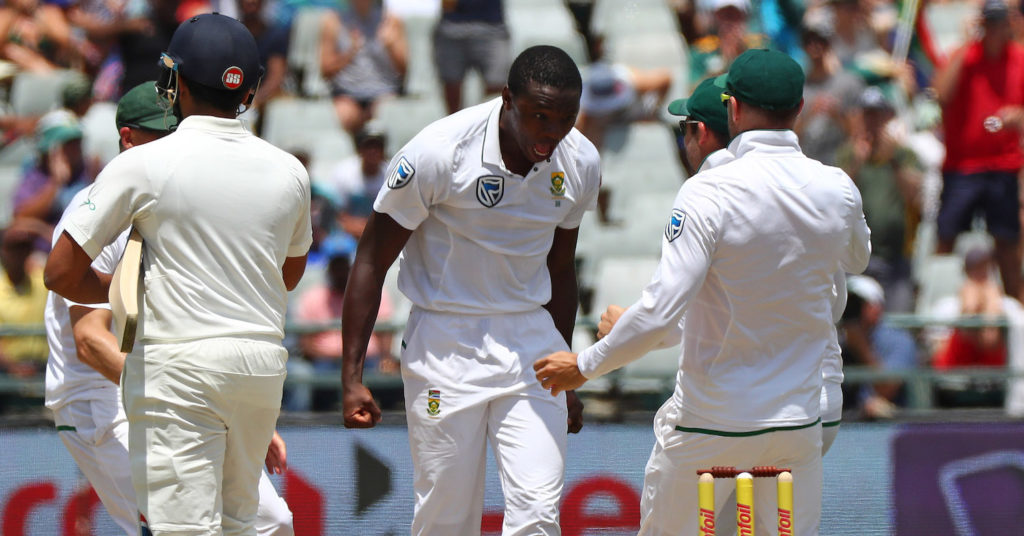The Proteas look set to reap the benefits of a four-prong seam attack in the short- and long-term.
Ottis Gibson failed to contain his excitement in the wake of the Proteas’ 72-run victory at Newlands. The result marked Gibson’s first real success with the Test side following comfortable yet largely meaningless wins against Bangladesh and Zimbabwe in late 2017.
South Africa were pushed hard by the world’s No 1-ranked team, India. They came through the contest with a monumental victory and, if the post-match comments by Gibson and skipper Faf du Plessis are any indicator, a new sense of identity.
The Proteas want to play aggressive cricket. Gibson highlighted AB de Villiers – who scored 65 in South Africa’s first innings and 35 in their second, the former a masterclass in counterattacking batting – as an example. They want seaming and bouncing tracks that suit their revamped attack and they want to persist with four seamers in the XI as often as possible.
‘I’m a former fast bowler,’ said Gibson after the game at Newlands. ‘I’m fast-bowler minded.
‘We should be looking to be physical. We should be using our strengths. If conditions are conducive, we should try to get four fast bowlers into the team [as often as possible].’
GARY LEMKE: Aggression key to SA’s success
The Newlands pitch served up an absorbing contest between bat and ball. Du Plessis and opposite number Virat Kohli said afterwards that they expect similar conditions when the teams meet at Centurion and then the Wanderers in the coming weeks. One would hope that Gibson and company persist with the bold yet necessary plan to include four fast bowlers.
Sadly, Dale Steyn sustained an injury at Newlands and will not feature again in this series. It’s a blow for the side, and yet Gibson remains optimistic that Steyn will feature against Australia later this season.
Steyn did not bowl at all in the fourth innings at Newlands. The Proteas – led by Vernon Philander – still managed to bowl India out for 135.
Gibson and Du Plessis both felt that South Africa could have dismissed India sooner, and that they may have won by a greater margin, if all four of their quicks were fit. However, when it was put to Gibson that that fourth-innings performance may have proved that only three seamers and a spinner are needed going forward, the coach disagreed.
Gibson always seems to have a smile on his face. That smile tends to broaden when he speaks about fast bowling.
Indeed, Gibson appeared to be most enthusiastic when listing the talent at South Africa’s disposal. The fact that the Proteas can field a medium-pacer of Philander’s extraordinary skill as well as three genuine quickies with the ability to bowl 145 km/h is significant.
Steyn and Morne Morkel have been be terrorising batsmen for over a decade. Kagiso Rabada is only 22, but has bowled with the accuracy as well as the aggressive intent of an older bowler. Rabada was recently elevated to the top of the ICC Test rankings.
There’s no respite for the opposition batsmen in a scenario that sees Steyn, Philander, Morkel and Rabada operating as a combination. And if South Africa continues to field such an attack, they may well develop an aura to rival that of the great West Indian sides of the 1970s and 80s.
ALSO READ: Rabada is world No 1
Already there’s a buzz about South Africa’s ‘Four Horsemen of the Apocalypse’. Perhaps such labels are premature in the wake of one strong showing. What cannot be denied, though, is that the collective bowling performance at Newlands has generated some optimism about the Proteas and what appears to be a more combative mindset.
Gibson touched on this subject after the win at Newlands. Two bowlers, Duanne Olivier and Lungi Ngidi, have been called up ahead of the next two Tests against India. That brings the seam-bowling contingent in the current squad up to seven (Chris Morris and Andile Phehlukwayo are also in the mix).
The Proteas coach stressed the importance of good asset management over the next few months. It’s clear that Gibson and the selectors are serious about a fast and furious approach.
Workloads need to be managed over the next six Tests. We’re unlikely to see the same four seamers operating as a combination over that period. Injuries, and possibly the return of Steyn, may lead to a change. The overall approach and mindset needs to be consistent, though.
Morris has to be the favourite to replace Steyn at Centurion and the Wanderers. A pace-attack that includes Philander, Morkel, Morris and Rabada still boasts a fearsome look, and should be a handful in lively conditions.
Photo: Chris Ricco/BackpagePix







